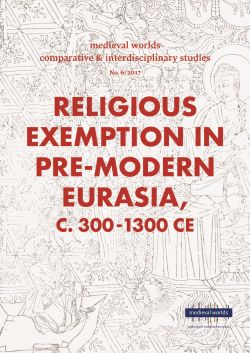Walter POHL – Andre GINGRICH (Eds.)
medieval worlds • no. 6 • 2017
Religious Exemption in Pre-Modern Eurasia, C. 300-1300 CE
Thomas Kohl
S. 217 - 230
doi:
10.1553/medievalworlds_no6_2017s217
Verlag der Österreichischen Akademie der Wissenschaften
Abstract:
While immunities were perhaps the most important form of religious exemption in the medieval West throughout the Middle Ages, they have not been studied extensively for the period around the turn of the millennium. This paper treats immunities from the perspective of the institutions that received them, drawing on the example of the bishops of Worms in southwestern Germany. Two questions are asked: 1) What did institutions expect from receiving immunities? 2) Can we tell if they had consequences in practice? The unique sources from Worms – a dossier of forged or interpolated royal charters created by Bishop Hildibald of Worms (978-998), and numerous documents connected to his successor Burchard (1000-1025) – make it possible to study these questions in depth. Hildibald’s charters were one important starting point in the redrawing of regional power structures in favour of the church of Worms and thus its developing territorial lordship. In part, they expanded property and immunity rights, but Hildibald’s forgeries were mostly concerned with specifying and defining the terms of immunity that his church already possessed in face of regional competition by the monastery of Lorsch and by the Salian dukes and counts. This suggests that practical advantages in terms of income and power were what made immunities interesting for a church. Hildibald’s successor Burchard used his close ties to Emperor Henry II to achieve a large degree of independence from these regional political powers, relying in part on Hildibald’s forged charters. As a result of this, the counts’ powers in and around Worms were all but abolished, and judicial matters lay in the hand of the bishop. These changes in the regional power structure were accompanied by outbreaks of violence, which were countered by the emperor’s intervention and the promulgation of new laws by the bishop.
immunities; Worms; justice; Burchard of Worms; Hildibald of Worms; charters; forgeries
Published Online:
2017/12/01 11:46:49
Object Identifier:
0xc1aa5576 0x00372f29
Rights:All rights reserved.For questions regarding copyright and copies please contact us by email.
MEDIEVAL WORLDS provides a new forum for interdisciplinary and transcultural studies of the Middle Ages. Specifically it encourages and links comparative research between different regions and fields and promotes methodological innovation in transdisciplinary studies. Focusing on the Middle Ages (c. 400-1500 CE, but can be extended whenever thematically fruitful or appropriate), MEDIEVAL WORLDS takes a global approach to studying history in a comparative setting.
MEDIEVAL WORLDS is open to regular submissions on comparative topics, but also offers the possibility to propose or advertise subjects that lend themselves to comparison. With a view to connecting people working on related topics in different academic environments, we publish calls for matching articles and for contributions on particular issues.
Table of Contents
Religious Exemption in Pre-Modern Eurasia, c. 300 – 1300 CE: Introduction
Charles West
Treasures in Heaven: Defining the Eurasian Old Regime?
R. I. Moore
Envisioning a No-Man’s Land: Hermitage as a Site of Exemption in Ancient and Early Medieval
Indian Literature
Kanad Sinha
Evolving Relationship between the Buddhist Monastic Order and the Imperial States of Medieval
China
Mario Poceski
The Normative Character of Monastic Exemption in the Early Medieval Latin West
Kriston R. Rennie
Clerical Exemption in Canon Law from Gratian to the Decretals
Anne J. Duggan
Nothing to Declare: Status, Power and Religious Aspiration in the Policies of Taxation in Ancient
India
Ulrich Pagel
Exemption Not Granted: The Confrontation between Buddhism and the Chinese State in Late
Antiquity and the ‘First Great Divergence’ Between China and Western Eurasia
Antonello Palumbo
The Political Significance of Gifts of Power in the Khmer and Mercian Kingdoms 793-926
Dominic Goodall and Andrew Wareham
Conversion, Exemption, and Manipulation: Social Benefits and Conversion to Islam in Late Antiquity
and the Middle Ages
Uriel Simonsohn
Religious Exemption, Justice, and Territories around the Year 1000: The Forgeries of Worms
Thomas Kohl
The Exemption that Proves the Rule: Autonomy and Authority between Alcuin, Theodulf and
Charlemagne (802)
Rutger Kramer
From Symbiosis to Separate Spheres? England, 1163
Judith A. Green
Religious Exemption and Global History before 1300 – Closing Comments
Julia McClure




 Home
Home Print
Print
 References
References
 Share
Share
